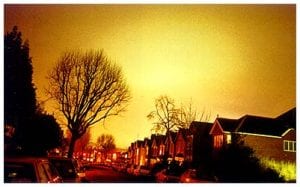Light pollution affects many animals in our ecosystems that rely on the Earth’s cycle of natural light and darkness to survive. For many animals, light and dark signals to them when to eat, sleep, hunt, migrate, or reproduce. Some of these animals include sea turtles, bats, moths, birds, toads, zooplankton, wallabies, bees, and many more. Nocturnal animals sleep during the day and are active at night. The artificial light that we use is harshly disrupting their nighttime environment by essentially turning night into day. Diurnal creatures sleep at night and are active during the day, so the artificial light at night affects their sleep cycle, production of melatonin, and circadian rhythm just as it affects humans.
Sea turtles lay their eggs on beaches, and when they hatch, the hatchlings move away from the dark silhouettes of the sand dunes toward the brighter horizon of the ocean. However, many coastal areas are becoming heavily populated and these artificial lights are causing the sea turtles to go in the wrong direction. It leads them away from the safety of the ocean where they can experience dehydration, predators, or be run over by cars. Any reduction in the amount of artificial lights near beaches can help the safety of sea turtles.

Artificial light also attracts bugs. It is extremely harmful to these creatures because it acts as a vacuum that they cannot escape. Florida’s Fish and Wildlife Conservation Commission states, “Even one artificial light source can disrupt normal flight activity, long-distance migrations, or even attract insects that don’t normally move from their habitat.” When these bugs stay on the light for too long, they tend to die from overheating. Moths are typically the victim of this, which affects the birds and bats that feed on them because they lose a food source. Light pollution also affects the life cycle of plants and can prevent them from growing flowers and reproducing. This affects the pollinators of these plants and also their own life cycles. According to the National Academies Press’ Booklet “Resources on Pollinators,” one-third of human food requires a pollinator. Therefore, our food sources are being disrupted by light pollution.
Light pollution confuses nocturnal birds. These birds use the starlight and moonlight to navigate their routes. Artificial light from buildings can cause these creatures to be led astray and collide into them, leaving them injured for predators or to their deaths. They could also potentially circle their light source endlessly and could die from exhaustion.
Glare from artificial light affects amphibians, who detect light levels 100x dimmer than humans. Certain amphibians such as frogs and toads croak at night as a part of their breeding rituals. The light interferes with this process and disrupts their reproduction, therefore reducing their populations. Long exposure to artificial light also affects their hormones, skin coloration, and thermoregulation. Not only does light pollution affect the reproduction of amphibians, but it also affects the reproduction of wallabies. Artificial light causes wallabies to delay their births, which can be detrimental to their young because it puts them out of sync with the food that they need to feed their newborns.

Darkness is also required by certain animals for proper communication. Two examples are fireflies and coyotes. Fireflies emit a bioluminescent light from their bodies and it can range from adult mating signals to young larvae warning off predators. These messages can be often interrupted by unwanted and unneeded artificial light. It is also important for coyotes because they howl more during the time of a new moon when the sky is the darkest. Scientists believe they do this to reduce trespassing from other packs or to help with hunting larger prey during dark conditions. A bright sky reduces their howling, which could disrupt territorial marking and group hunting.
Light pollution also disrupts the reproduction of coral reefs. All coral reproduce in one way or another in correspondence with the moonlight. It is a very intricate and synchronized process in which the detection of moonlight intensity triggers vast numbers of coral and invertebrate species to release their eggs and sperm into the water. Failure to synchronize this annual event will reduce successful fertilization. The moon is a very important part of this process, and therefore the bright urban lights can mask the moon’s phases which throws the corals’ biological clocks out of sync.





